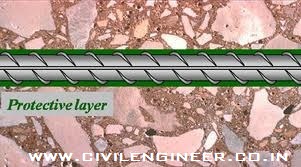

PROTECTION OF REINFORCEMENT
AGAINST CORROSION
The protection of reinforcement against corrosion can be done by any of the following method:
a) Anti-corrosive treatment using acid / alkali / other agents based on CECRI technology (as per IS: 9077).
b) Fusion bonded Epoxy coating (as per IS:13620).
c) Corrosion resistant reinforcement as rolled in the factory and commercially available.
Anti-corrosive treatment (using CECRI technology)
The procedure for anti-corrosive treatment of reinforcement is as follows:
- The reinforcement rods is immersed in the pickling tank, containing Derusting Solution.
- The reinforcements are then left in the derusting solution until all the rust is satisfactorily removed and a bright surface is obtained. This may take about 15-30 minutes. Typically, to prepare 100 litres of Derusting Solution, mix 5 liters of Inhibitor – Derusting solution, 50 liters of Hydrochloric acid and 50 liters of water in the pickling tank (as per manufacturer’s instruction).
- The rods is then removed from the pickling tank cleaned with wet waste cloth and immersed in the ALKALINE CLEANING TANK. This tank contains Alkaline Powder in the ratio of 1.5 kg. of powder to 400 liters of water. The rods is left for about 5 minutes, cleaned and removed.
- Phosphating Jelly is then immediately applied on the surface of the rods by means of a fibre brush. The jelly shall be allowed to react with the rod surface for 45-60 minutes and the jelly removed by means of rinsing in water or wet cloth.
- Corrosion inhibitor solution is then applied on the reinforcement surface by brushing/dipping.
- The corrosion inhibitor solution is mixed with ordinary portland cement in the ratio of 500 CC of inhibitor to 1 kg of OPC and a brushable slurry is prepared. This slurry is then be applied on the rod surface by brushing.
Note: All above steps should be applied in the same day and the steel allowed to air dry for 12 – 24 hours.
- Corrosion sealing solution is then be applied by brushing / dipping.
- Inhibitor is mixed with ordinary portland cement in the ratio of 600 CC of inhibitor to 1 kg. of cement and a brushable slurry is prepared. This slurry is immediately applied on the reinforcement surface. The coating is then allowed to dry for 12 – 24 hours.
- Corrosion sealing solution is applied on the reinforcement surface. This coating is again repeated after 4 hours of air drying.
The above Anticorrosive treatment is given after the rods are cut and bent to shape. The treatment is done in a covered area. The treated rods is stored above ground in a covered area on wooden / masonry supports.
Typical Mechanical Properties of anticorrosive coating are:
a) Average thickness of coating = 0.3 ± 0.1 mm
b) Rockwell superficial hardness = 40 HR 15 N
Typical Corrosion Resistance properties are as under:
a) Tolerable limit for Chloride In 0.04 N, NaOH as per Anodic Polarisation Technique – 5000 ppm
b) Corrosion resistance as per salt fog test – > 2000 hrs.
c) Corrosion resistance as per
d) alternative wetting and drying test – > 450 days
Fusion Bonded Epoxy Coating
This process shall be done as per IS: 13620. This process is carried out by the specialized agency in their Plant.
Commercially available corrosion resistant reinforcement:
The reinforcement are purchased from well-known brand of corrosion resistant rods. The mechanical properties like tensile strength, elongation etc. should conform to the requirements of the corresponding class of bars, like Fe 415, Fe 500 etc. as per IS-1786.
